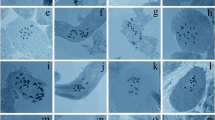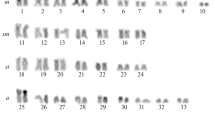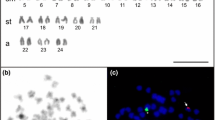Abstract
Tribe Cestreae is monophyletic with three genera: Cestrum, Sessea, and Vestia. Karyotypically, it is outstanding within Solanaceae by several features: (1) basic number x = 8, (2) large chromosome sizes, (3) complex heterochromatin patterns, (4) occurrence of B-chromosomes (Bs) in Cestrum with particular banding patterns and rDNA sites distribution, and (5) absence of Arabidopsis-type telomeres. Seventeen South American Cestreae species from the three genera were studied using fluorescence in situ hybridization (FISH) with ribosomal DNA regions (5S and 18-5.8-26S) as probes, with the aim of recognizing specific or group-specific chromosomal markers and analyzing karyotype diversity in a systematic and evolutionary context. The first chromosome number report for Cestrum euanthes, C. kunthii, C. lorentzianum, and C. tomentosum is included. Variation in number and distribution of rDNA loci was observed among the species, concerning both As and Bs chromosomes. Despite the constancy of the karyotype and numbers of rDNA loci, the mapping of 18-5.8-26S and 5S rDNA loci allowed to differentiate Cestreae genera and species groups within Cestrum, highlighting the importance of these markers as cytotaxonomic character in this tribe.




Similar content being viewed by others
References
Acosta MC, Moscone EA (2011) B chromosomes in Nierembergia aristata (Solanaceae): nucleolar activity and competition with the A chromosomes. Cytogenet Genome Res 132:105–112
Benítez de Rojas C, D’Arcy WG (1998) The genera Cestrum and Sessea (Solanaceae: Cestreae) in Venezuela. Ann Missouri Bot Gard 85:273–351
Benítez de Rojas C, Nee M (2001) The neotropical genus Sessea (Solanaceae): a preliminary survey. In: van de Berr RG, Barendse GWM, van der Werden GM, Mariani C (eds) Solanaceae V: advances in taxonomy and utilization. Nijmegen University Press, Nijmegen, pp 153–159
Berg C, Greilhuber J (1992) Cold-sensitive chromosome regions and their relation to constitutive heterochromatin in Cestrum parqui (Solanaceae). Genome 35:921–930
Berg C, Greilhuber J (1993) Cold-sensitive chromosome regions and heterochromatin in Cestrum (Solanaceae): C. strigillatum, C. fasciculatum, and C. elegans. Pl Syst Evol 185:133–151
Bolkhovskikh Z, Grif V, Matvejeva T, Zakharyeva O (1969) Chromosome numbers of flowering plants. O. Koeltz Sci Publ, Koenigstein
Camacho JPM, Sharbel TF, Beukeboom LW (2000) B chromosome evolution. Philos Trans Ser B 355:163–178
Carvalho L, Schnnoor A (1997) Sessea Carv. Et Schnoor, uma nova seçao para o genero Cestrum. Rodriguésia 45:15–24
Chiarini FE, Santiñaque FF, Urdampilleta JD, Las Peñas ML (2014) Genome size and karyotype diversity in Solanum sect. Acanthophora (Solanaceae). Pl Syst Evol 300:113–125
Dunal MF (1852) Solanaceae. In: de Candolle A (ed) Prodromus, vol 13. Paris, pp 1–690
Faini FR, Torres A, Castillo M (1984) (25R)-isonuatigenin, an unusual steroidal sapogenin from Vestia lycioides. Phytochemistry 23:1301–1306
Fay MF, Olmstead RG, Richardson JE, Santiago-Valentin E, Prance GT, Chase MW (1998) Molecular data support the inclusion of Duckeodendron cestroides in Solanaceae. Kew Bull 53:203–212
Fernandes T, de Rego Almeida L, Nardy M, Yuyama PM, Vanzela ALL (2009) Karyotype differentiation of four Cestrum species (Solanaceae) revealed by fluorescent chromosome banding and FISH. Genet Molec Biol 32:320–327
Francey P (1935) Monographie du genre Cestrum L. Candollea 6:46–398
Francey P (1936) Monographie du genre Cestrum L., partie II. Candollea 7:1–132
Fregonezi JN, Rocha C, Torezan JMD, Vanzela ALL (2004) The occurrence of different Bs in Cestrum intermedium and C. strigilatum (Solanaceae) evidenced by chromosome banding. Cytogenet Genome Res 106:184–188
Fregonezi JN, Fernandes T, Torezan JMD, Vieira AOS, Vanzela ALL (2006) Karyotype differentiation of four Cestrum species (Solanaceae) based on the physical mapping of repetitive DNA. Genet Mol Biol 29:97–104
Fregonezi JN, Vilas-Boas LA, Fungaro MHP, Gaeta ML, Vanzela ALL (2007) Distribution of a Ty3/gypsy-like retroelement on the A and B-chromosomes of Cestrum strigilatum Ruiz & Pav. And Cestrum intermedium Sendtn. (Solanaceae). Genet Molec Biol 30:599–604
Garcia S, Garnatje T, Kovarik A (2012) Plant rDNA database: ribosomal DNA loci information goes online. Chromosoma 121:389–394
Gerlach WL, Bedbrook JR (1979) Cloning and characterization of ribosomal RNA genes from wheat and barley. Nucl Acids Res 7:1869–1885
Goldblatt P (1984). Index to plant chromosome numbers 1979–1981. Monogr Syst Bot Missouri Bot Gard vol. 8, St. Louis
Goldblatt P, Johnson DE (1991) Index to plant chromosome numbers 1988–1989. Monogr Syst Bot Missouri Bot Gard vol. 40, St. Louis
Goldblatt P, Johnson DE (1996) Index to plant chromosome numbers 1992–1993. Monogr Syst Bot Missouri Bot Gard vol. 58, St. Louis
Guerra M (1983) O uso do Giemsa em Citogenética Vegetal: comparação entre a coloração simples e o bandamento. Ciênc Cult 35:190–193
Houben A, Banaei-Moghaddam AM, Klemme S, Timmis JN (2014) Evolution and biology of supernumerary B chromosomes. Cell Molec Life Sci 71:467–478
Hunziker AT (2001) Genera Solanacearum. The genera of Solanaceae illustrated, arranged according to a new system. A. R. G. Gantner Verlag, Rugell
Jones N, Houben A (2003) B chromosomes in plants: escapees from the A chromosome genome? Trends Pl Sci 8:417–423
Klemme S, Banaei-Moghaddam AM, Macas J, Wicker T, Novak P, Houben A (2013) High-copy sequences reveal distinct evolution of the rye B chromosome. New Phytol 199:550–558
Kokubugata G, Forster PI (2006) Molecular-cytotaxonomy of Cycas (Cycadales) using 5S ribosomal DNA markers. Nat Sci Mus Monogr 34:163–170
Lamb JC, Riddle NC, Cheng YM, Theuri J, Birchler JA (2007) Localization and transcription of a retrotransposon-derived element on the maize B chromosome. Chromosome Res 15:383–398
Lan T, Albert V (2011) Dynamic distribution patterns of ribosomal DNA and chromosomal evolution in Paphiopedilum, a lady’s slipper orchid. BMC Plant Biol 11:126
Las Peñas ML, Chiarini FE, Bernardello G, Benítez de Rojas C (2006) Karyotypes of some species of Cestrum, Sessea, and Vestia (tribe Cestreae, Solanaceae). Caryologia 59:131–137
Levan A, Sandberg A, Fredga K (1964) Nomenclature for centromeric position on chromosomes. Hereditas 52:201–220
Liu ZL, Zhang D, Hong DY, Wang XR (2003) Chromosomal localization of 5S and 18S–5.8S–25S ribosomal DNA sites in five Asian pines using fluorescence in situ hybridization. Theor Appl Genet 106:198–204
Montero-Castro JC, Delgado-Salinas A, De Luna E, Eguiarte LE (2006) Phylogenetic analysis of Cestrum Section Habrothamnus (Solanaceae) based on plastid and nuclear DNA sequences. Syst Bot 31:843–850
Moscone EA (1992) Estudios de cromosomas meióticos en Solanaceae de Argentina. Darwiniana 31:261–297
Olmstead RJ, Palmer JD (1992) A chloroplast DNA phylogeny of the Solanaceae: subfamilial relationships and character evolution. Ann Missouri Bot Gard 79:346–360
Olmstead RJ, Sweere JA, Spangler RE, Bohs L, Palmer JD (1999) Phylogeny and provisional classification of the Solanaceae based on chloroplast DNA. In: Nee M, Symon DE, Lester RN, Jessop JP (eds) Solanaceae IV. Royal Bot Gard, Kew, pp 111–137
Olmstead RG, Bohs L, Migid HA, Santiago-Valentin E, Garcia VF, Collier SM (2008) A molecular phylogeny of the Solanaceae. Taxon 57:1159–1181
Ran Y, Hammett KRW, Murray BG (2001) Phylogenetic analysis and karyotype evolution in the genus Clivia (Amaryllidaceae). Ann Bot (Oxford) 87:823–830
Raskina O, Barber JC, Nevo E, Belyayev A (2008) Repetitive DNA and chromosomal rearrangements: speciation-related events in plant genomes. Cytogenet Genome Res 120:351–357
Roa F, Guerra M (2012) Distribution of 45S rDNA sites in chromosomes of plants: structural and evolutionary implications. BMC Evol Biol 12:1–13
Romanutti A, Hunziker AT (1998) Cestreae Solanaceae, parte 7. In: Hunziker AT (ed) Flora Fanerogámica Argentina. Proflora-Conicet, Córdoba, pp 1–14
Santiago-Valentin E, Olmstead RG (2003) Phylogenetics of the Antillean Goetzeoideae (Solanaceae) and their relationships within the Solanaceae based on chloroplast and ITS DNA sequence data. Syst Bot 28:452–460
Särkinen T, Bohs L, Olmstead RG, Knapp S (2013) A phylogenetic framework for evolutionary study of the nightshades (Solanaceae): a dated 1000-tip tree. BMC Evol Biol 13:214
Schubert I, Wobus U (1985) In situ hybridization confirms jumping nucleolus organizing regions in Allium. Chromosoma 92:143–148
Schwarzacher TP, Heslop-Harrison P (2000) Practical in situ hybridization, 2nd edn. Bios, Oxford
Sharma AK, Sharma A (1957) Karyotype studies in Cestrum as an aid to taxonomy. Genetica 29:83–100
Shibata F, Hizume M (2002) Evolution of 5S rDNA units and their chromosomal localization in Allium cepa and Allium schoenoprasum revealed by microdissection and FISH. Theor Appl Genet 105:167–172
Sykorova E, Lim KY, Chase MW, Knapp S, Leitch IJ, Leitch AR, Fajkus J (2003a) The absence of Arabidopsis-type telomeres in Cestrum and closely related genera Vestia and Sessea (Solanaceae): first evidence from eudicots. Pl J 34:283–291
Sykorova E, Lim KY, Fajkus J, Leitch AR (2003b) The signature of the Cestrumgenome suggests an evolutionary response to the loss of (TTTAGGG)n telomeres. Chromosoma 112:164–172
Tate JA, Acosta MC, McDill J, Moscone EA, Simpson BB, Cocucci AA (2009) Phylogeny and character evolution in Nierembergia (Solanaceae): molecular, morphological, and cytogenetic evidence. Syst Bot 34:198–206
Tschischow NT (1956) Número de cromosomas de algunas plantas chilenas. Bol Soc Biol Concepción 31:145–147
Urdampilleta JD, Coulleri JP, Ferrucci MS, Forni-Martins ER (2013) Karyotype evolution and phylogenetic analyses in the genus Cardiospermum L. (Paullinieae, Sapindaceae). Pl Biol 15:868–881
Acknowledgments
The authors are grateful to the Argentinean agencies: CONICET, ANPCyT—FONCyT, MINCyT—Córdoba, and SECyT—Universidad Nacional de Córdoba for financial support and Dr. Gloria Barboza for determination and collection of plant materials.
Author information
Authors and Affiliations
Corresponding author
Additional information
Handling editor: Eric Schranz.
Rights and permissions
About this article
Cite this article
Urdampilleta, J.D., Chiarini, F., Stiefkens, L. et al. Chromosomal differentiation of Tribe Cestreae (Solanaceae) by analyses of 18-5.8-26S and 5S rDNA distribution. Plant Syst Evol 301, 1325–1334 (2015). https://doi.org/10.1007/s00606-014-1158-x
Received:
Accepted:
Published:
Issue Date:
DOI: https://doi.org/10.1007/s00606-014-1158-x




